Report on Business Ethics, Sustainability, and Corporate Practices
VerifiedAdded on 2021/05/29
|18
|4443
|123
Report
AI Summary
This report delves into the critical areas of business ethics and sustainability, providing a comprehensive overview of their applications and implications. It begins by defining ethics and business ethics, exploring their importance in fostering customer loyalty, enhancing company reputation, and avoiding legal issues. The report then examines the concept of sustainability, emphasizing its significance for businesses and offering practical recommendations for implementation. Furthermore, it discusses three models of Corporate Social Responsibility (CSR), providing a framework for understanding different approaches to ethical business practices. The report also analyzes Google's Code of Conduct, highlighting its key components and implications. Overall, the report offers valuable insights into ethical business practices, sustainability, and CSR, providing students with a solid understanding of these essential concepts.

<Title Page>
Page | 1
Page | 1
Paraphrase This Document
Need a fresh take? Get an instant paraphrase of this document with our AI Paraphraser
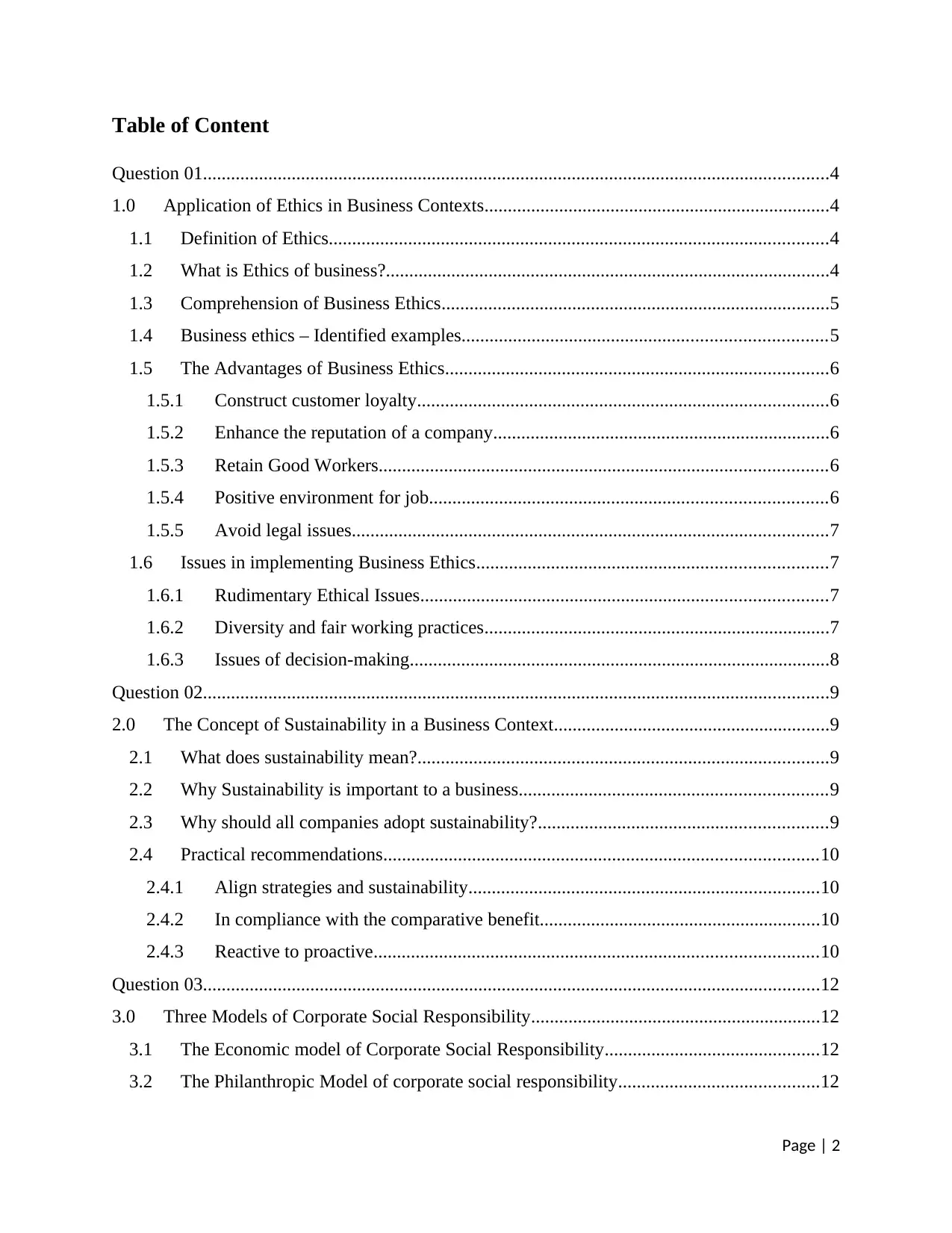
Table of Content
Question 01......................................................................................................................................4
1.0 Application of Ethics in Business Contexts..........................................................................4
1.1 Definition of Ethics...........................................................................................................4
1.2 What is Ethics of business?...............................................................................................4
1.3 Comprehension of Business Ethics...................................................................................5
1.4 Business ethics – Identified examples..............................................................................5
1.5 The Advantages of Business Ethics..................................................................................6
1.5.1 Construct customer loyalty........................................................................................6
1.5.2 Enhance the reputation of a company........................................................................6
1.5.3 Retain Good Workers................................................................................................6
1.5.4 Positive environment for job.....................................................................................6
1.5.5 Avoid legal issues......................................................................................................7
1.6 Issues in implementing Business Ethics...........................................................................7
1.6.1 Rudimentary Ethical Issues.......................................................................................7
1.6.2 Diversity and fair working practices..........................................................................7
1.6.3 Issues of decision-making..........................................................................................8
Question 02......................................................................................................................................9
2.0 The Concept of Sustainability in a Business Context...........................................................9
2.1 What does sustainability mean?........................................................................................9
2.2 Why Sustainability is important to a business..................................................................9
2.3 Why should all companies adopt sustainability?..............................................................9
2.4 Practical recommendations.............................................................................................10
2.4.1 Align strategies and sustainability...........................................................................10
2.4.2 In compliance with the comparative benefit............................................................10
2.4.3 Reactive to proactive...............................................................................................10
Question 03....................................................................................................................................12
3.0 Three Models of Corporate Social Responsibility..............................................................12
3.1 The Economic model of Corporate Social Responsibility..............................................12
3.2 The Philanthropic Model of corporate social responsibility...........................................12
Page | 2
Question 01......................................................................................................................................4
1.0 Application of Ethics in Business Contexts..........................................................................4
1.1 Definition of Ethics...........................................................................................................4
1.2 What is Ethics of business?...............................................................................................4
1.3 Comprehension of Business Ethics...................................................................................5
1.4 Business ethics – Identified examples..............................................................................5
1.5 The Advantages of Business Ethics..................................................................................6
1.5.1 Construct customer loyalty........................................................................................6
1.5.2 Enhance the reputation of a company........................................................................6
1.5.3 Retain Good Workers................................................................................................6
1.5.4 Positive environment for job.....................................................................................6
1.5.5 Avoid legal issues......................................................................................................7
1.6 Issues in implementing Business Ethics...........................................................................7
1.6.1 Rudimentary Ethical Issues.......................................................................................7
1.6.2 Diversity and fair working practices..........................................................................7
1.6.3 Issues of decision-making..........................................................................................8
Question 02......................................................................................................................................9
2.0 The Concept of Sustainability in a Business Context...........................................................9
2.1 What does sustainability mean?........................................................................................9
2.2 Why Sustainability is important to a business..................................................................9
2.3 Why should all companies adopt sustainability?..............................................................9
2.4 Practical recommendations.............................................................................................10
2.4.1 Align strategies and sustainability...........................................................................10
2.4.2 In compliance with the comparative benefit............................................................10
2.4.3 Reactive to proactive...............................................................................................10
Question 03....................................................................................................................................12
3.0 Three Models of Corporate Social Responsibility..............................................................12
3.1 The Economic model of Corporate Social Responsibility..............................................12
3.2 The Philanthropic Model of corporate social responsibility...........................................12
Page | 2
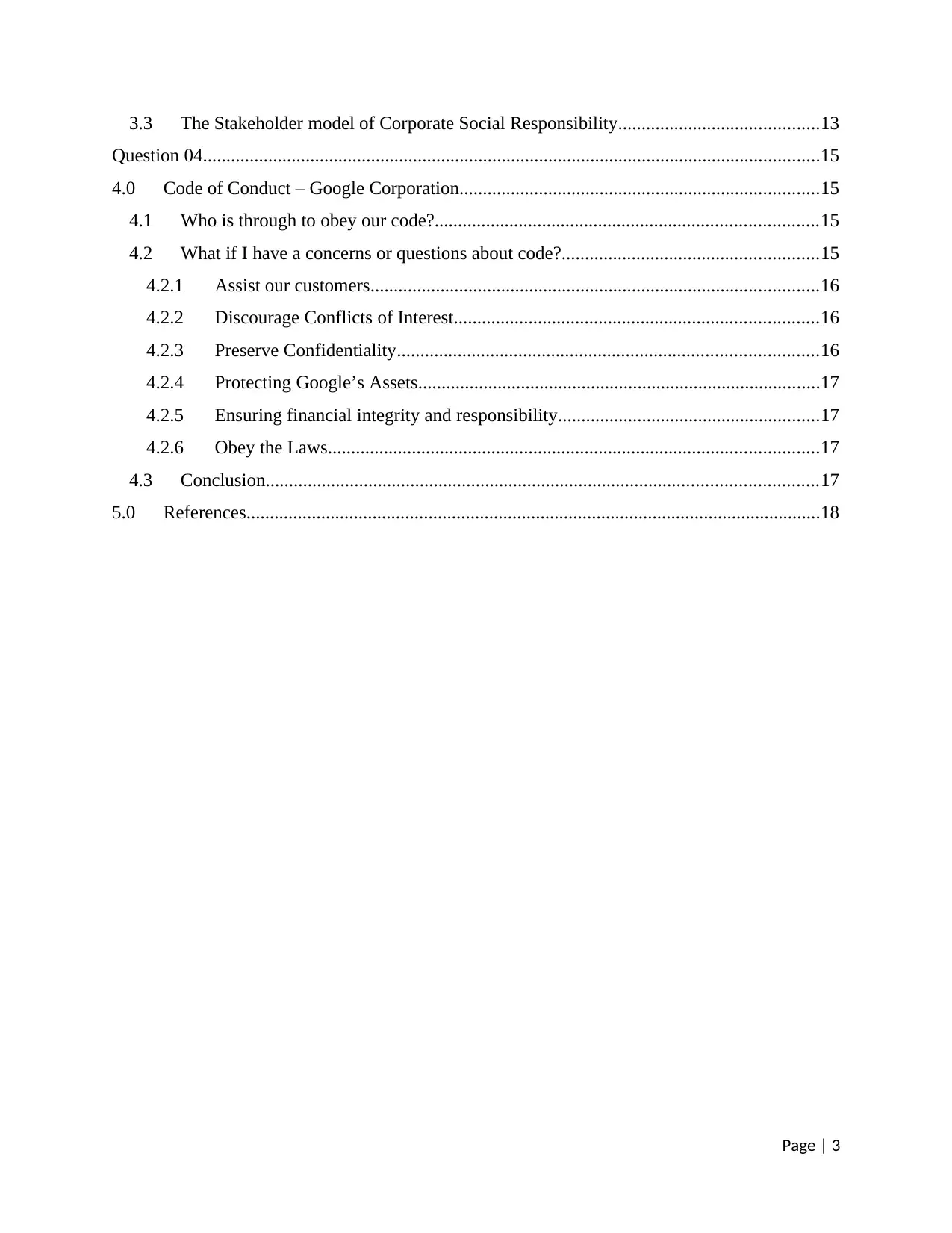
3.3 The Stakeholder model of Corporate Social Responsibility...........................................13
Question 04....................................................................................................................................15
4.0 Code of Conduct – Google Corporation.............................................................................15
4.1 Who is through to obey our code?..................................................................................15
4.2 What if I have a concerns or questions about code?.......................................................15
4.2.1 Assist our customers................................................................................................16
4.2.2 Discourage Conflicts of Interest..............................................................................16
4.2.3 Preserve Confidentiality..........................................................................................16
4.2.4 Protecting Google’s Assets......................................................................................17
4.2.5 Ensuring financial integrity and responsibility........................................................17
4.2.6 Obey the Laws.........................................................................................................17
4.3 Conclusion......................................................................................................................17
5.0 References...........................................................................................................................18
Page | 3
Question 04....................................................................................................................................15
4.0 Code of Conduct – Google Corporation.............................................................................15
4.1 Who is through to obey our code?..................................................................................15
4.2 What if I have a concerns or questions about code?.......................................................15
4.2.1 Assist our customers................................................................................................16
4.2.2 Discourage Conflicts of Interest..............................................................................16
4.2.3 Preserve Confidentiality..........................................................................................16
4.2.4 Protecting Google’s Assets......................................................................................17
4.2.5 Ensuring financial integrity and responsibility........................................................17
4.2.6 Obey the Laws.........................................................................................................17
4.3 Conclusion......................................................................................................................17
5.0 References...........................................................................................................................18
Page | 3
⊘ This is a preview!⊘
Do you want full access?
Subscribe today to unlock all pages.

Trusted by 1+ million students worldwide
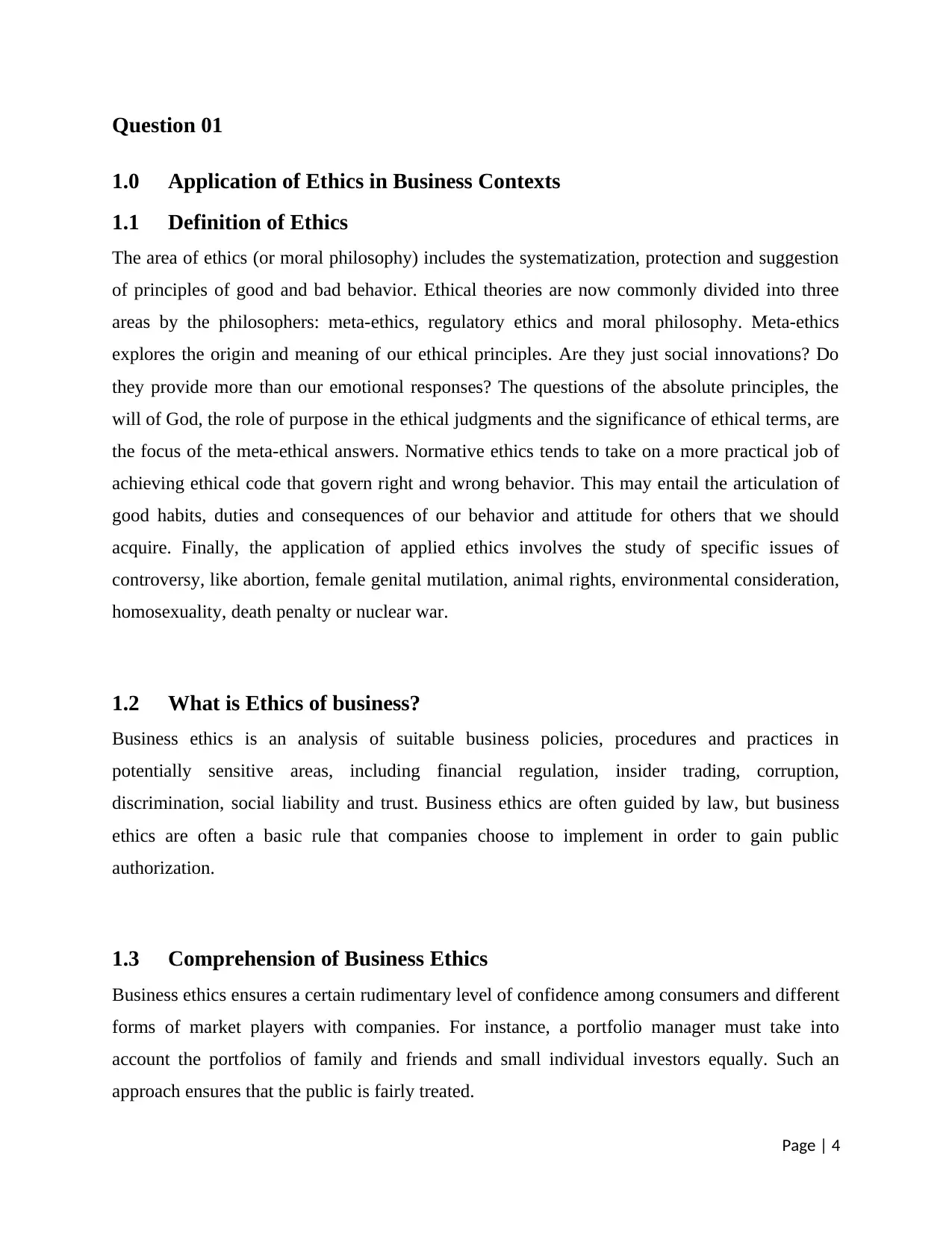
Question 01
1.0 Application of Ethics in Business Contexts
1.1 Definition of Ethics
The area of ethics (or moral philosophy) includes the systematization, protection and suggestion
of principles of good and bad behavior. Ethical theories are now commonly divided into three
areas by the philosophers: meta-ethics, regulatory ethics and moral philosophy. Meta-ethics
explores the origin and meaning of our ethical principles. Are they just social innovations? Do
they provide more than our emotional responses? The questions of the absolute principles, the
will of God, the role of purpose in the ethical judgments and the significance of ethical terms, are
the focus of the meta-ethical answers. Normative ethics tends to take on a more practical job of
achieving ethical code that govern right and wrong behavior. This may entail the articulation of
good habits, duties and consequences of our behavior and attitude for others that we should
acquire. Finally, the application of applied ethics involves the study of specific issues of
controversy, like abortion, female genital mutilation, animal rights, environmental consideration,
homosexuality, death penalty or nuclear war.
1.2 What is Ethics of business?
Business ethics is an analysis of suitable business policies, procedures and practices in
potentially sensitive areas, including financial regulation, insider trading, corruption,
discrimination, social liability and trust. Business ethics are often guided by law, but business
ethics are often a basic rule that companies choose to implement in order to gain public
authorization.
1.3 Comprehension of Business Ethics
Business ethics ensures a certain rudimentary level of confidence among consumers and different
forms of market players with companies. For instance, a portfolio manager must take into
account the portfolios of family and friends and small individual investors equally. Such an
approach ensures that the public is fairly treated.
Page | 4
1.0 Application of Ethics in Business Contexts
1.1 Definition of Ethics
The area of ethics (or moral philosophy) includes the systematization, protection and suggestion
of principles of good and bad behavior. Ethical theories are now commonly divided into three
areas by the philosophers: meta-ethics, regulatory ethics and moral philosophy. Meta-ethics
explores the origin and meaning of our ethical principles. Are they just social innovations? Do
they provide more than our emotional responses? The questions of the absolute principles, the
will of God, the role of purpose in the ethical judgments and the significance of ethical terms, are
the focus of the meta-ethical answers. Normative ethics tends to take on a more practical job of
achieving ethical code that govern right and wrong behavior. This may entail the articulation of
good habits, duties and consequences of our behavior and attitude for others that we should
acquire. Finally, the application of applied ethics involves the study of specific issues of
controversy, like abortion, female genital mutilation, animal rights, environmental consideration,
homosexuality, death penalty or nuclear war.
1.2 What is Ethics of business?
Business ethics is an analysis of suitable business policies, procedures and practices in
potentially sensitive areas, including financial regulation, insider trading, corruption,
discrimination, social liability and trust. Business ethics are often guided by law, but business
ethics are often a basic rule that companies choose to implement in order to gain public
authorization.
1.3 Comprehension of Business Ethics
Business ethics ensures a certain rudimentary level of confidence among consumers and different
forms of market players with companies. For instance, a portfolio manager must take into
account the portfolios of family and friends and small individual investors equally. Such an
approach ensures that the public is fairly treated.
Page | 4
Paraphrase This Document
Need a fresh take? Get an instant paraphrase of this document with our AI Paraphraser
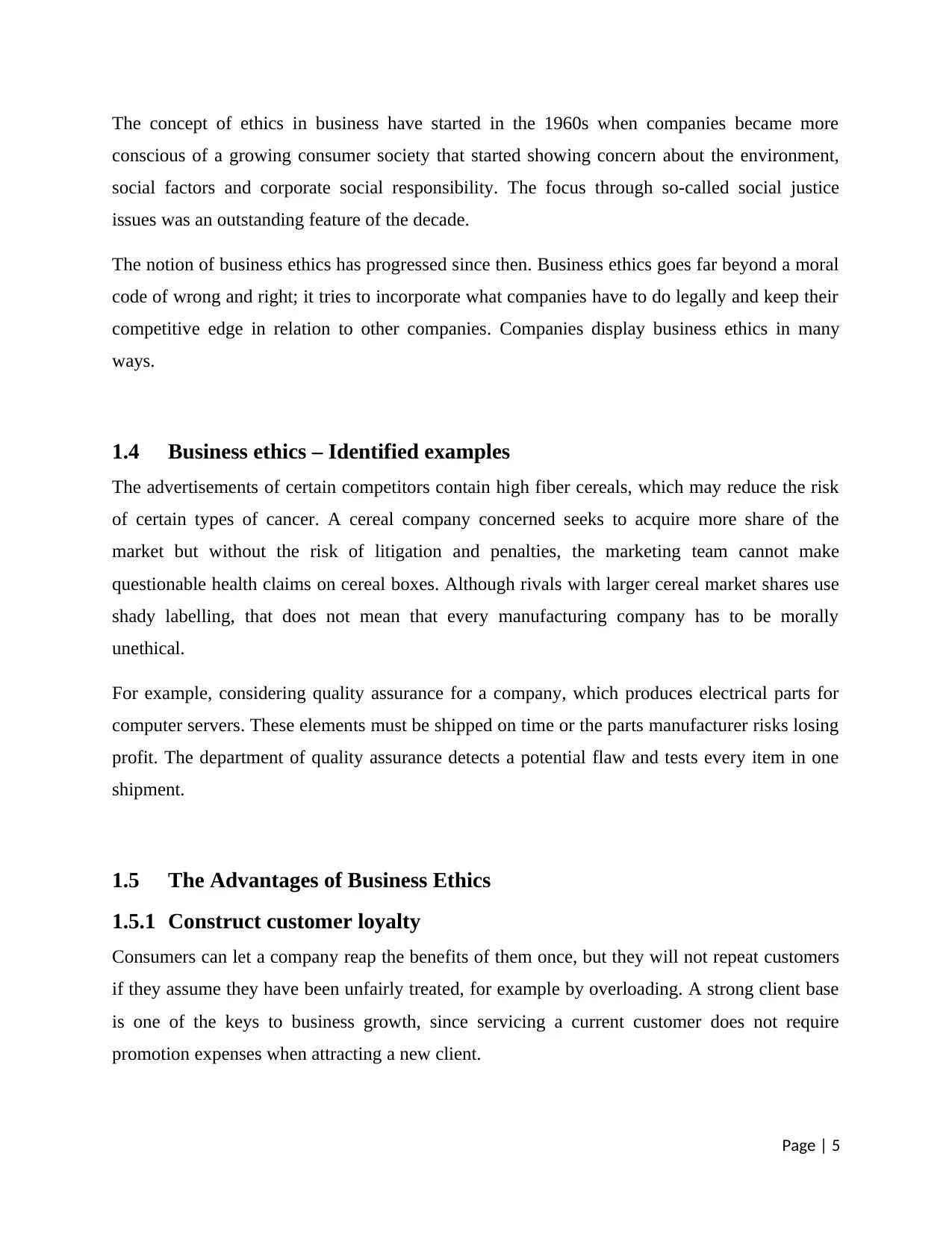
The concept of ethics in business have started in the 1960s when companies became more
conscious of a growing consumer society that started showing concern about the environment,
social factors and corporate social responsibility. The focus through so-called social justice
issues was an outstanding feature of the decade.
The notion of business ethics has progressed since then. Business ethics goes far beyond a moral
code of wrong and right; it tries to incorporate what companies have to do legally and keep their
competitive edge in relation to other companies. Companies display business ethics in many
ways.
1.4 Business ethics – Identified examples
The advertisements of certain competitors contain high fiber cereals, which may reduce the risk
of certain types of cancer. A cereal company concerned seeks to acquire more share of the
market but without the risk of litigation and penalties, the marketing team cannot make
questionable health claims on cereal boxes. Although rivals with larger cereal market shares use
shady labelling, that does not mean that every manufacturing company has to be morally
unethical.
For example, considering quality assurance for a company, which produces electrical parts for
computer servers. These elements must be shipped on time or the parts manufacturer risks losing
profit. The department of quality assurance detects a potential flaw and tests every item in one
shipment.
1.5 The Advantages of Business Ethics
1.5.1 Construct customer loyalty
Consumers can let a company reap the benefits of them once, but they will not repeat customers
if they assume they have been unfairly treated, for example by overloading. A strong client base
is one of the keys to business growth, since servicing a current customer does not require
promotion expenses when attracting a new client.
Page | 5
conscious of a growing consumer society that started showing concern about the environment,
social factors and corporate social responsibility. The focus through so-called social justice
issues was an outstanding feature of the decade.
The notion of business ethics has progressed since then. Business ethics goes far beyond a moral
code of wrong and right; it tries to incorporate what companies have to do legally and keep their
competitive edge in relation to other companies. Companies display business ethics in many
ways.
1.4 Business ethics – Identified examples
The advertisements of certain competitors contain high fiber cereals, which may reduce the risk
of certain types of cancer. A cereal company concerned seeks to acquire more share of the
market but without the risk of litigation and penalties, the marketing team cannot make
questionable health claims on cereal boxes. Although rivals with larger cereal market shares use
shady labelling, that does not mean that every manufacturing company has to be morally
unethical.
For example, considering quality assurance for a company, which produces electrical parts for
computer servers. These elements must be shipped on time or the parts manufacturer risks losing
profit. The department of quality assurance detects a potential flaw and tests every item in one
shipment.
1.5 The Advantages of Business Ethics
1.5.1 Construct customer loyalty
Consumers can let a company reap the benefits of them once, but they will not repeat customers
if they assume they have been unfairly treated, for example by overloading. A strong client base
is one of the keys to business growth, since servicing a current customer does not require
promotion expenses when attracting a new client.
Page | 5
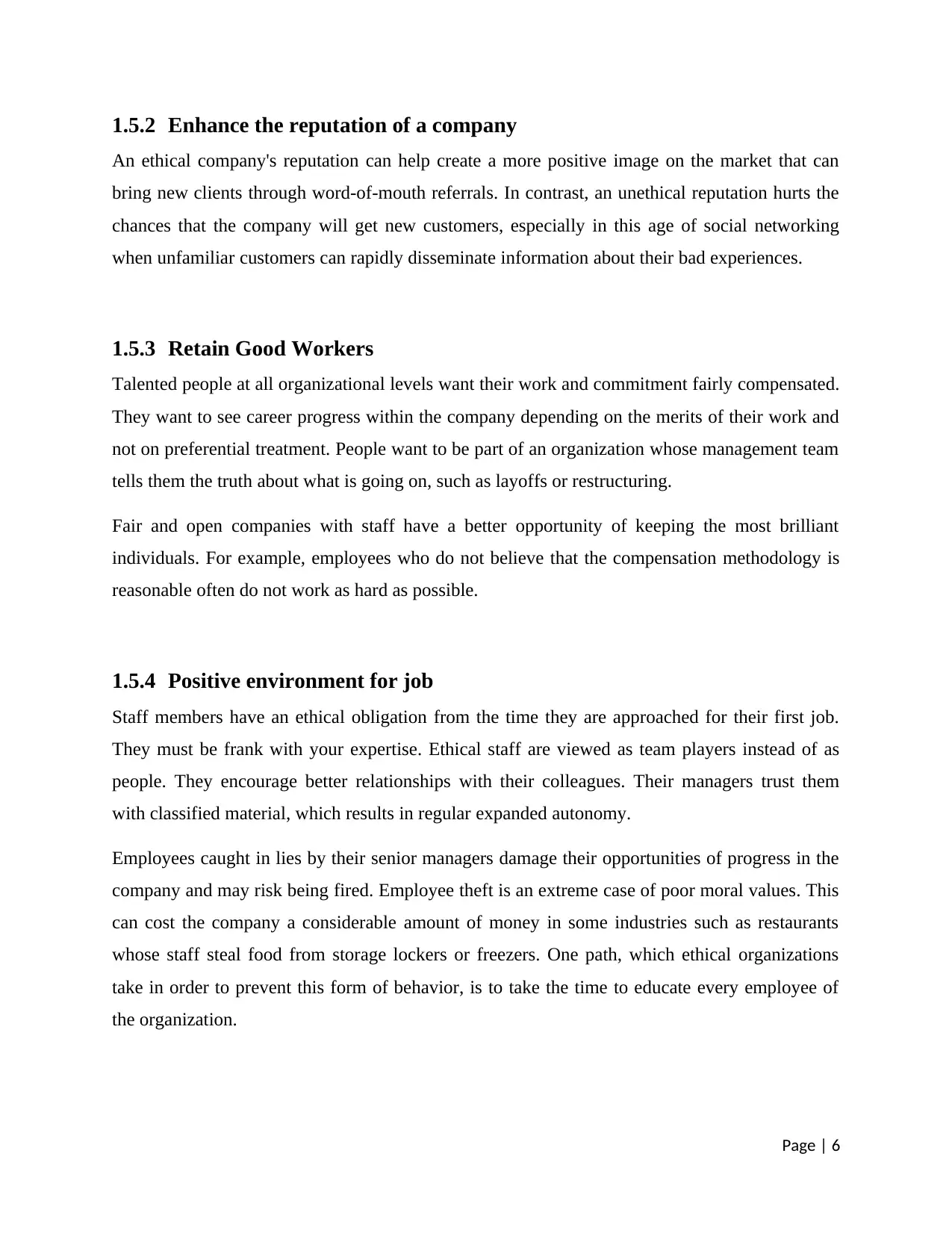
1.5.2 Enhance the reputation of a company
An ethical company's reputation can help create a more positive image on the market that can
bring new clients through word-of-mouth referrals. In contrast, an unethical reputation hurts the
chances that the company will get new customers, especially in this age of social networking
when unfamiliar customers can rapidly disseminate information about their bad experiences.
1.5.3 Retain Good Workers
Talented people at all organizational levels want their work and commitment fairly compensated.
They want to see career progress within the company depending on the merits of their work and
not on preferential treatment. People want to be part of an organization whose management team
tells them the truth about what is going on, such as layoffs or restructuring.
Fair and open companies with staff have a better opportunity of keeping the most brilliant
individuals. For example, employees who do not believe that the compensation methodology is
reasonable often do not work as hard as possible.
1.5.4 Positive environment for job
Staff members have an ethical obligation from the time they are approached for their first job.
They must be frank with your expertise. Ethical staff are viewed as team players instead of as
people. They encourage better relationships with their colleagues. Their managers trust them
with classified material, which results in regular expanded autonomy.
Employees caught in lies by their senior managers damage their opportunities of progress in the
company and may risk being fired. Employee theft is an extreme case of poor moral values. This
can cost the company a considerable amount of money in some industries such as restaurants
whose staff steal food from storage lockers or freezers. One path, which ethical organizations
take in order to prevent this form of behavior, is to take the time to educate every employee of
the organization.
Page | 6
An ethical company's reputation can help create a more positive image on the market that can
bring new clients through word-of-mouth referrals. In contrast, an unethical reputation hurts the
chances that the company will get new customers, especially in this age of social networking
when unfamiliar customers can rapidly disseminate information about their bad experiences.
1.5.3 Retain Good Workers
Talented people at all organizational levels want their work and commitment fairly compensated.
They want to see career progress within the company depending on the merits of their work and
not on preferential treatment. People want to be part of an organization whose management team
tells them the truth about what is going on, such as layoffs or restructuring.
Fair and open companies with staff have a better opportunity of keeping the most brilliant
individuals. For example, employees who do not believe that the compensation methodology is
reasonable often do not work as hard as possible.
1.5.4 Positive environment for job
Staff members have an ethical obligation from the time they are approached for their first job.
They must be frank with your expertise. Ethical staff are viewed as team players instead of as
people. They encourage better relationships with their colleagues. Their managers trust them
with classified material, which results in regular expanded autonomy.
Employees caught in lies by their senior managers damage their opportunities of progress in the
company and may risk being fired. Employee theft is an extreme case of poor moral values. This
can cost the company a considerable amount of money in some industries such as restaurants
whose staff steal food from storage lockers or freezers. One path, which ethical organizations
take in order to prevent this form of behavior, is to take the time to educate every employee of
the organization.
Page | 6
⊘ This is a preview!⊘
Do you want full access?
Subscribe today to unlock all pages.

Trusted by 1+ million students worldwide
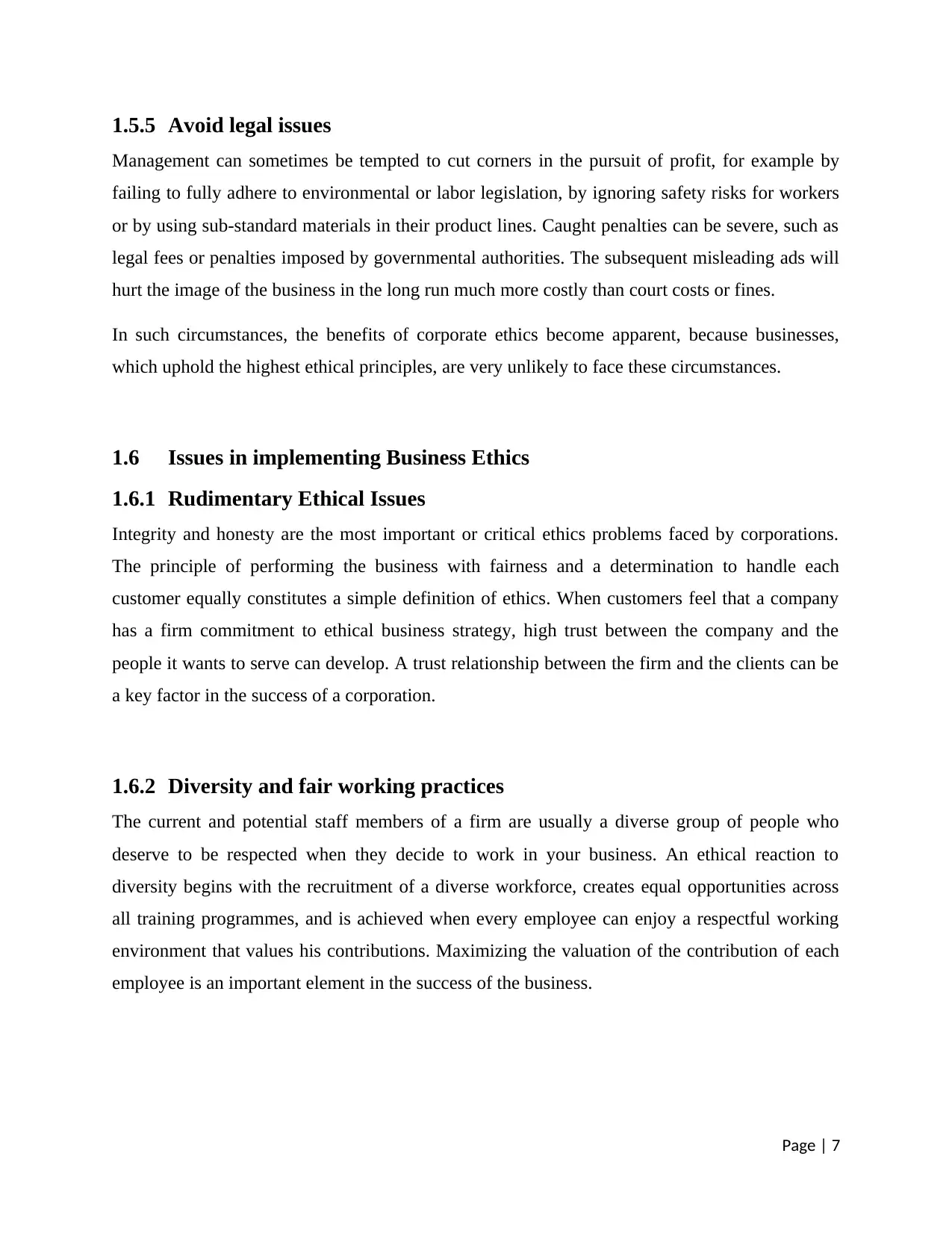
1.5.5 Avoid legal issues
Management can sometimes be tempted to cut corners in the pursuit of profit, for example by
failing to fully adhere to environmental or labor legislation, by ignoring safety risks for workers
or by using sub-standard materials in their product lines. Caught penalties can be severe, such as
legal fees or penalties imposed by governmental authorities. The subsequent misleading ads will
hurt the image of the business in the long run much more costly than court costs or fines.
In such circumstances, the benefits of corporate ethics become apparent, because businesses,
which uphold the highest ethical principles, are very unlikely to face these circumstances.
1.6 Issues in implementing Business Ethics
1.6.1 Rudimentary Ethical Issues
Integrity and honesty are the most important or critical ethics problems faced by corporations.
The principle of performing the business with fairness and a determination to handle each
customer equally constitutes a simple definition of ethics. When customers feel that a company
has a firm commitment to ethical business strategy, high trust between the company and the
people it wants to serve can develop. A trust relationship between the firm and the clients can be
a key factor in the success of a corporation.
1.6.2 Diversity and fair working practices
The current and potential staff members of a firm are usually a diverse group of people who
deserve to be respected when they decide to work in your business. An ethical reaction to
diversity begins with the recruitment of a diverse workforce, creates equal opportunities across
all training programmes, and is achieved when every employee can enjoy a respectful working
environment that values his contributions. Maximizing the valuation of the contribution of each
employee is an important element in the success of the business.
Page | 7
Management can sometimes be tempted to cut corners in the pursuit of profit, for example by
failing to fully adhere to environmental or labor legislation, by ignoring safety risks for workers
or by using sub-standard materials in their product lines. Caught penalties can be severe, such as
legal fees or penalties imposed by governmental authorities. The subsequent misleading ads will
hurt the image of the business in the long run much more costly than court costs or fines.
In such circumstances, the benefits of corporate ethics become apparent, because businesses,
which uphold the highest ethical principles, are very unlikely to face these circumstances.
1.6 Issues in implementing Business Ethics
1.6.1 Rudimentary Ethical Issues
Integrity and honesty are the most important or critical ethics problems faced by corporations.
The principle of performing the business with fairness and a determination to handle each
customer equally constitutes a simple definition of ethics. When customers feel that a company
has a firm commitment to ethical business strategy, high trust between the company and the
people it wants to serve can develop. A trust relationship between the firm and the clients can be
a key factor in the success of a corporation.
1.6.2 Diversity and fair working practices
The current and potential staff members of a firm are usually a diverse group of people who
deserve to be respected when they decide to work in your business. An ethical reaction to
diversity begins with the recruitment of a diverse workforce, creates equal opportunities across
all training programmes, and is achieved when every employee can enjoy a respectful working
environment that values his contributions. Maximizing the valuation of the contribution of each
employee is an important element in the success of the business.
Page | 7
Paraphrase This Document
Need a fresh take? Get an instant paraphrase of this document with our AI Paraphraser
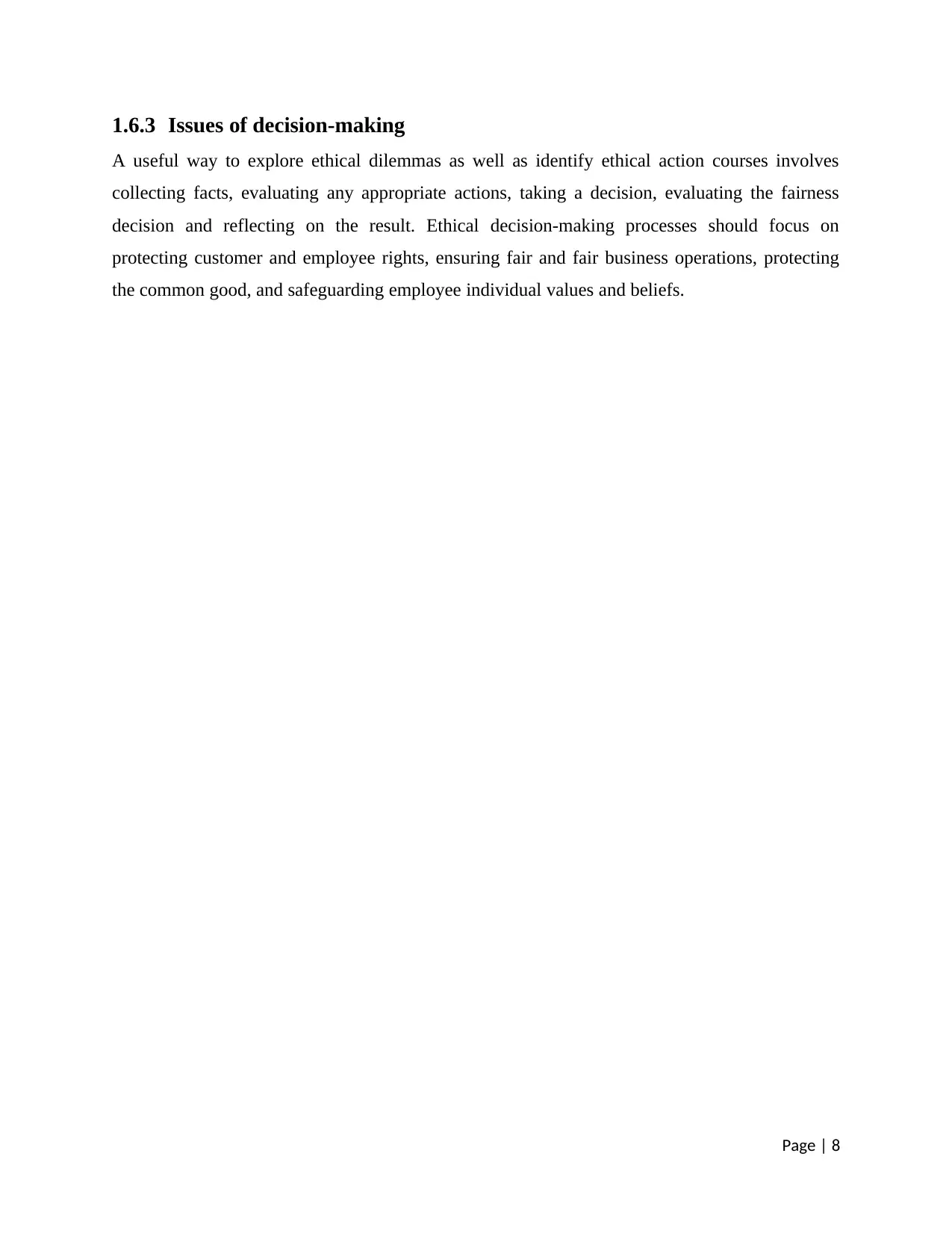
1.6.3 Issues of decision-making
A useful way to explore ethical dilemmas as well as identify ethical action courses involves
collecting facts, evaluating any appropriate actions, taking a decision, evaluating the fairness
decision and reflecting on the result. Ethical decision-making processes should focus on
protecting customer and employee rights, ensuring fair and fair business operations, protecting
the common good, and safeguarding employee individual values and beliefs.
Page | 8
A useful way to explore ethical dilemmas as well as identify ethical action courses involves
collecting facts, evaluating any appropriate actions, taking a decision, evaluating the fairness
decision and reflecting on the result. Ethical decision-making processes should focus on
protecting customer and employee rights, ensuring fair and fair business operations, protecting
the common good, and safeguarding employee individual values and beliefs.
Page | 8
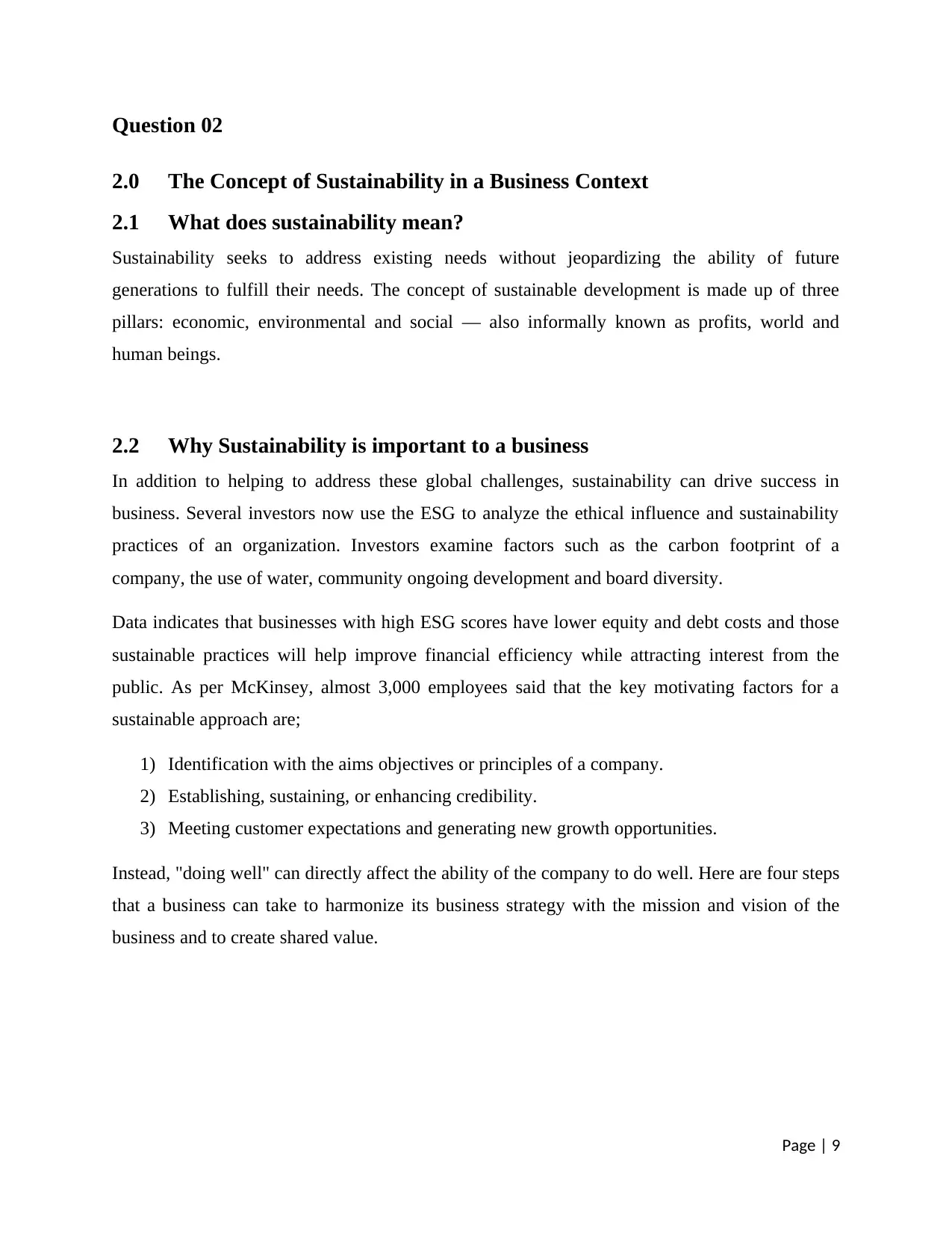
Question 02
2.0 The Concept of Sustainability in a Business Context
2.1 What does sustainability mean?
Sustainability seeks to address existing needs without jeopardizing the ability of future
generations to fulfill their needs. The concept of sustainable development is made up of three
pillars: economic, environmental and social — also informally known as profits, world and
human beings.
2.2 Why Sustainability is important to a business
In addition to helping to address these global challenges, sustainability can drive success in
business. Several investors now use the ESG to analyze the ethical influence and sustainability
practices of an organization. Investors examine factors such as the carbon footprint of a
company, the use of water, community ongoing development and board diversity.
Data indicates that businesses with high ESG scores have lower equity and debt costs and those
sustainable practices will help improve financial efficiency while attracting interest from the
public. As per McKinsey, almost 3,000 employees said that the key motivating factors for a
sustainable approach are;
1) Identification with the aims objectives or principles of a company.
2) Establishing, sustaining, or enhancing credibility.
3) Meeting customer expectations and generating new growth opportunities.
Instead, "doing well" can directly affect the ability of the company to do well. Here are four steps
that a business can take to harmonize its business strategy with the mission and vision of the
business and to create shared value.
Page | 9
2.0 The Concept of Sustainability in a Business Context
2.1 What does sustainability mean?
Sustainability seeks to address existing needs without jeopardizing the ability of future
generations to fulfill their needs. The concept of sustainable development is made up of three
pillars: economic, environmental and social — also informally known as profits, world and
human beings.
2.2 Why Sustainability is important to a business
In addition to helping to address these global challenges, sustainability can drive success in
business. Several investors now use the ESG to analyze the ethical influence and sustainability
practices of an organization. Investors examine factors such as the carbon footprint of a
company, the use of water, community ongoing development and board diversity.
Data indicates that businesses with high ESG scores have lower equity and debt costs and those
sustainable practices will help improve financial efficiency while attracting interest from the
public. As per McKinsey, almost 3,000 employees said that the key motivating factors for a
sustainable approach are;
1) Identification with the aims objectives or principles of a company.
2) Establishing, sustaining, or enhancing credibility.
3) Meeting customer expectations and generating new growth opportunities.
Instead, "doing well" can directly affect the ability of the company to do well. Here are four steps
that a business can take to harmonize its business strategy with the mission and vision of the
business and to create shared value.
Page | 9
⊘ This is a preview!⊘
Do you want full access?
Subscribe today to unlock all pages.

Trusted by 1+ million students worldwide
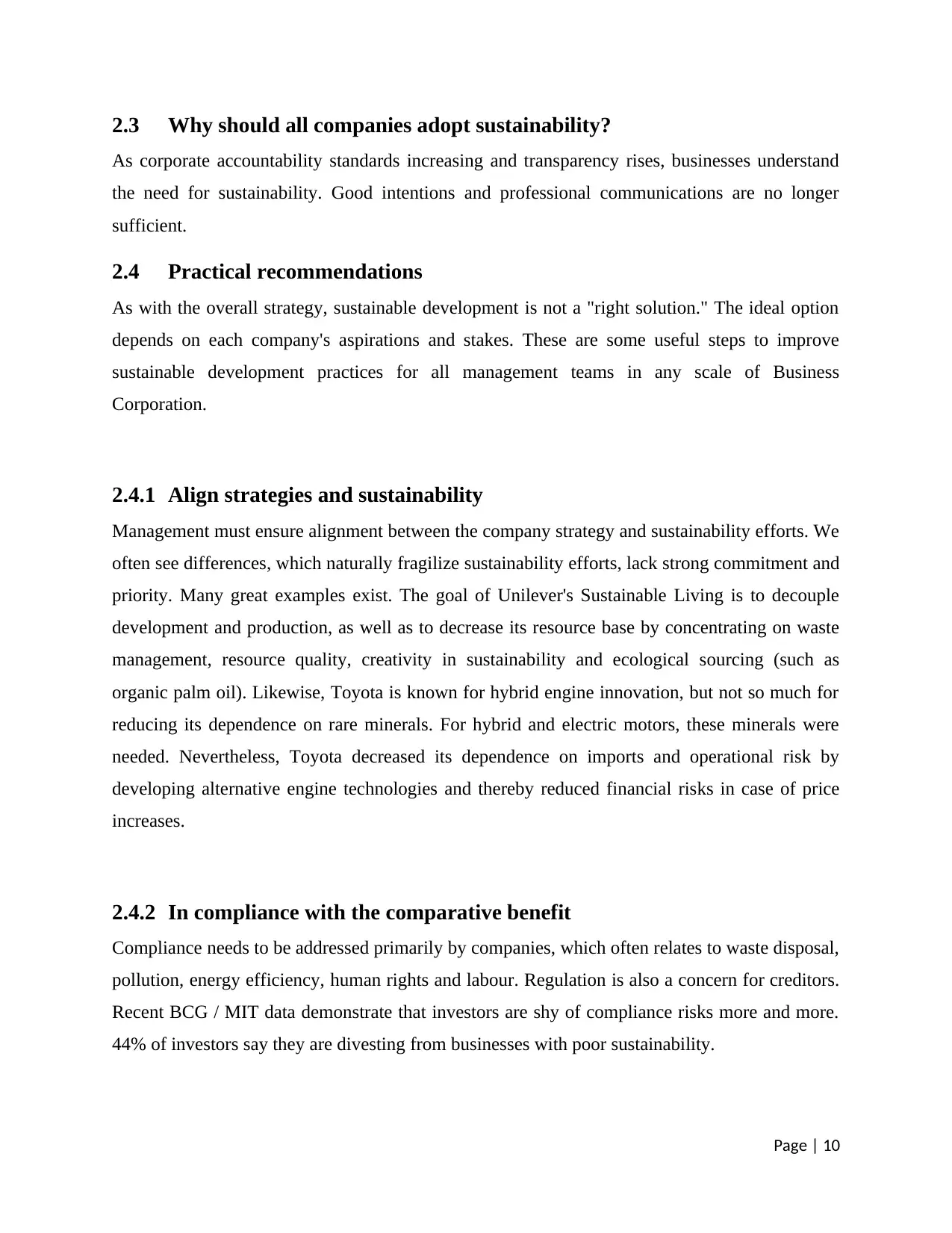
2.3 Why should all companies adopt sustainability?
As corporate accountability standards increasing and transparency rises, businesses understand
the need for sustainability. Good intentions and professional communications are no longer
sufficient.
2.4 Practical recommendations
As with the overall strategy, sustainable development is not a "right solution." The ideal option
depends on each company's aspirations and stakes. These are some useful steps to improve
sustainable development practices for all management teams in any scale of Business
Corporation.
2.4.1 Align strategies and sustainability
Management must ensure alignment between the company strategy and sustainability efforts. We
often see differences, which naturally fragilize sustainability efforts, lack strong commitment and
priority. Many great examples exist. The goal of Unilever's Sustainable Living is to decouple
development and production, as well as to decrease its resource base by concentrating on waste
management, resource quality, creativity in sustainability and ecological sourcing (such as
organic palm oil). Likewise, Toyota is known for hybrid engine innovation, but not so much for
reducing its dependence on rare minerals. For hybrid and electric motors, these minerals were
needed. Nevertheless, Toyota decreased its dependence on imports and operational risk by
developing alternative engine technologies and thereby reduced financial risks in case of price
increases.
2.4.2 In compliance with the comparative benefit
Compliance needs to be addressed primarily by companies, which often relates to waste disposal,
pollution, energy efficiency, human rights and labour. Regulation is also a concern for creditors.
Recent BCG / MIT data demonstrate that investors are shy of compliance risks more and more.
44% of investors say they are divesting from businesses with poor sustainability.
Page | 10
As corporate accountability standards increasing and transparency rises, businesses understand
the need for sustainability. Good intentions and professional communications are no longer
sufficient.
2.4 Practical recommendations
As with the overall strategy, sustainable development is not a "right solution." The ideal option
depends on each company's aspirations and stakes. These are some useful steps to improve
sustainable development practices for all management teams in any scale of Business
Corporation.
2.4.1 Align strategies and sustainability
Management must ensure alignment between the company strategy and sustainability efforts. We
often see differences, which naturally fragilize sustainability efforts, lack strong commitment and
priority. Many great examples exist. The goal of Unilever's Sustainable Living is to decouple
development and production, as well as to decrease its resource base by concentrating on waste
management, resource quality, creativity in sustainability and ecological sourcing (such as
organic palm oil). Likewise, Toyota is known for hybrid engine innovation, but not so much for
reducing its dependence on rare minerals. For hybrid and electric motors, these minerals were
needed. Nevertheless, Toyota decreased its dependence on imports and operational risk by
developing alternative engine technologies and thereby reduced financial risks in case of price
increases.
2.4.2 In compliance with the comparative benefit
Compliance needs to be addressed primarily by companies, which often relates to waste disposal,
pollution, energy efficiency, human rights and labour. Regulation is also a concern for creditors.
Recent BCG / MIT data demonstrate that investors are shy of compliance risks more and more.
44% of investors say they are divesting from businesses with poor sustainability.
Page | 10
Paraphrase This Document
Need a fresh take? Get an instant paraphrase of this document with our AI Paraphraser
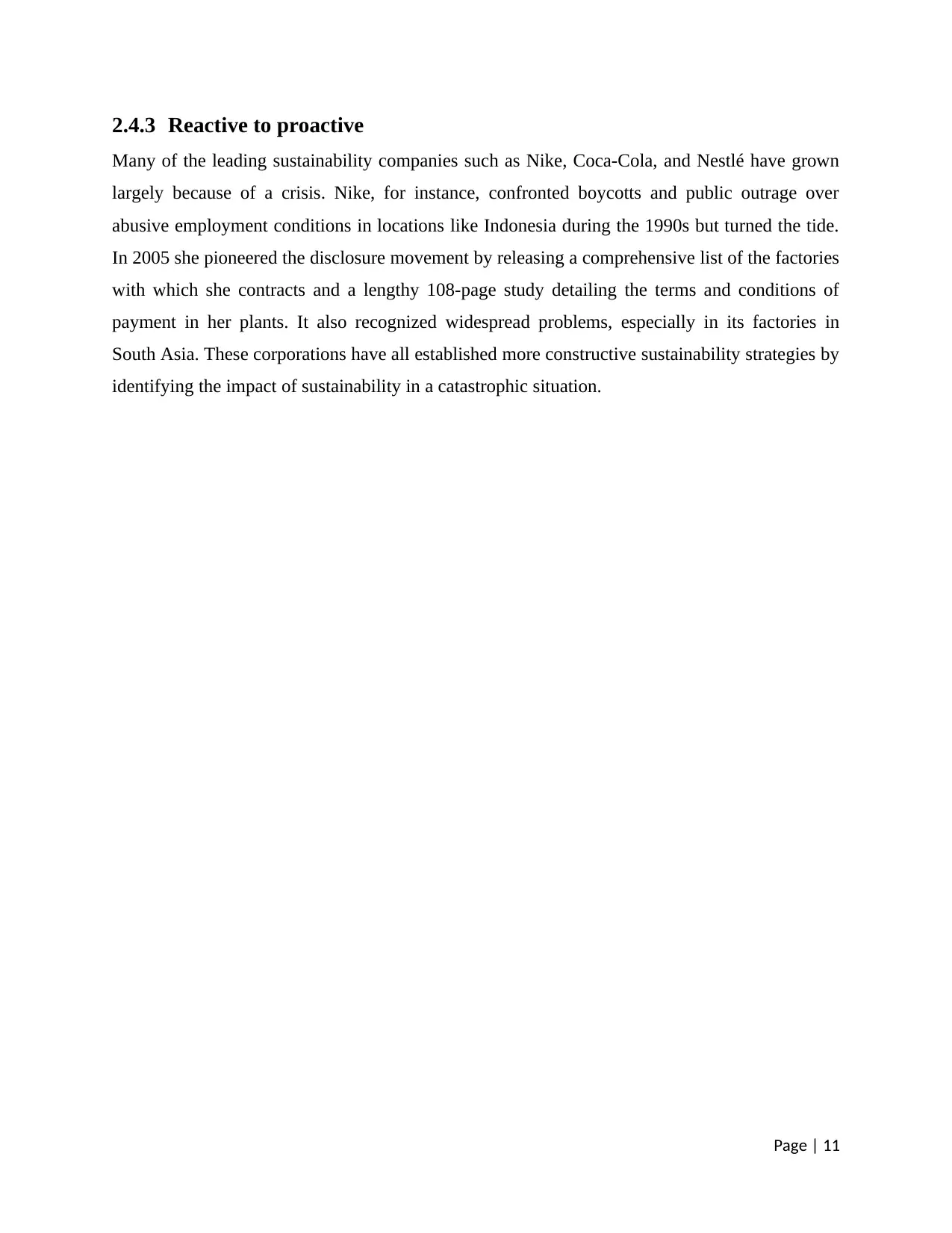
2.4.3 Reactive to proactive
Many of the leading sustainability companies such as Nike, Coca-Cola, and Nestlé have grown
largely because of a crisis. Nike, for instance, confronted boycotts and public outrage over
abusive employment conditions in locations like Indonesia during the 1990s but turned the tide.
In 2005 she pioneered the disclosure movement by releasing a comprehensive list of the factories
with which she contracts and a lengthy 108-page study detailing the terms and conditions of
payment in her plants. It also recognized widespread problems, especially in its factories in
South Asia. These corporations have all established more constructive sustainability strategies by
identifying the impact of sustainability in a catastrophic situation.
Page | 11
Many of the leading sustainability companies such as Nike, Coca-Cola, and Nestlé have grown
largely because of a crisis. Nike, for instance, confronted boycotts and public outrage over
abusive employment conditions in locations like Indonesia during the 1990s but turned the tide.
In 2005 she pioneered the disclosure movement by releasing a comprehensive list of the factories
with which she contracts and a lengthy 108-page study detailing the terms and conditions of
payment in her plants. It also recognized widespread problems, especially in its factories in
South Asia. These corporations have all established more constructive sustainability strategies by
identifying the impact of sustainability in a catastrophic situation.
Page | 11
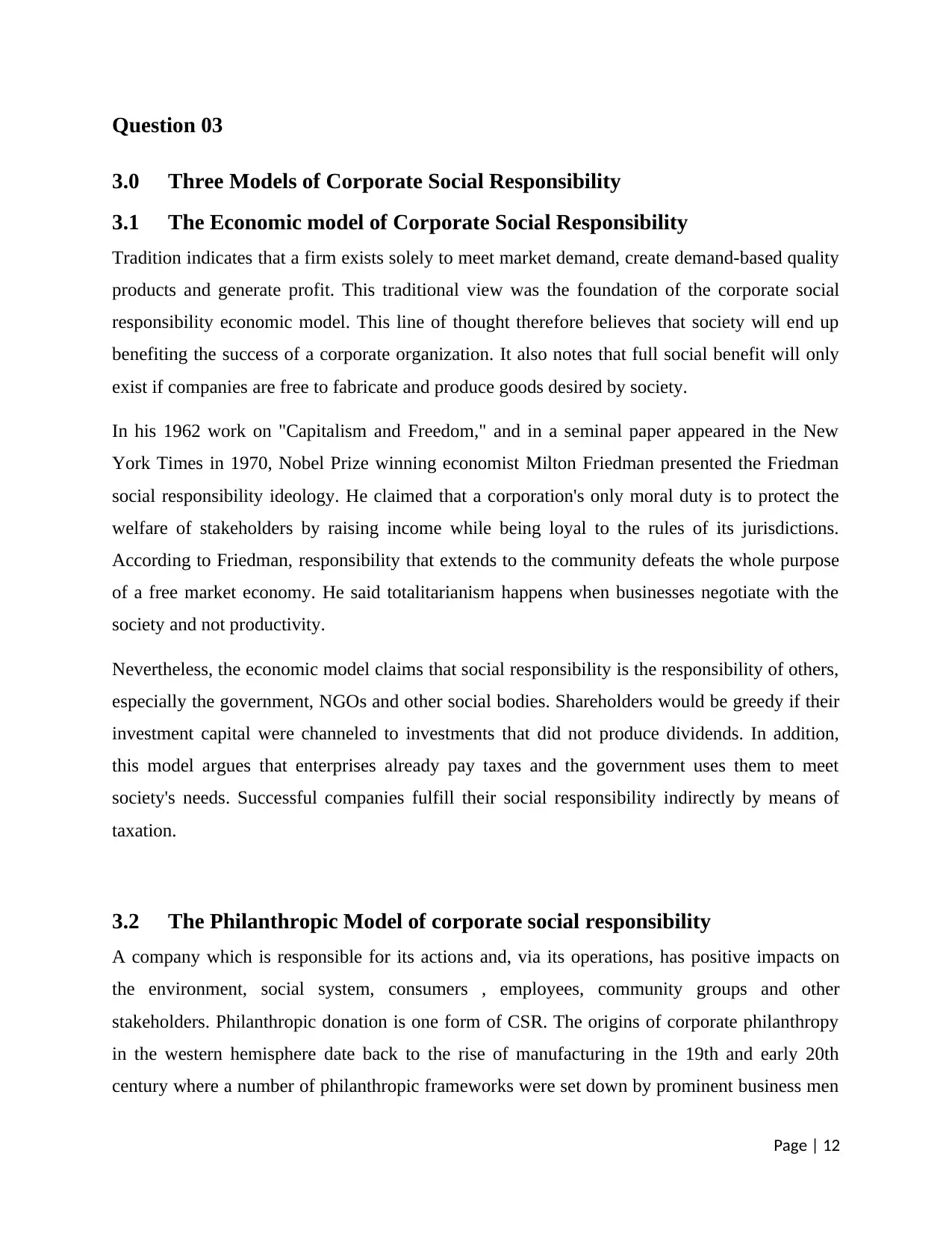
Question 03
3.0 Three Models of Corporate Social Responsibility
3.1 The Economic model of Corporate Social Responsibility
Tradition indicates that a firm exists solely to meet market demand, create demand-based quality
products and generate profit. This traditional view was the foundation of the corporate social
responsibility economic model. This line of thought therefore believes that society will end up
benefiting the success of a corporate organization. It also notes that full social benefit will only
exist if companies are free to fabricate and produce goods desired by society.
In his 1962 work on "Capitalism and Freedom," and in a seminal paper appeared in the New
York Times in 1970, Nobel Prize winning economist Milton Friedman presented the Friedman
social responsibility ideology. He claimed that a corporation's only moral duty is to protect the
welfare of stakeholders by raising income while being loyal to the rules of its jurisdictions.
According to Friedman, responsibility that extends to the community defeats the whole purpose
of a free market economy. He said totalitarianism happens when businesses negotiate with the
society and not productivity.
Nevertheless, the economic model claims that social responsibility is the responsibility of others,
especially the government, NGOs and other social bodies. Shareholders would be greedy if their
investment capital were channeled to investments that did not produce dividends. In addition,
this model argues that enterprises already pay taxes and the government uses them to meet
society's needs. Successful companies fulfill their social responsibility indirectly by means of
taxation.
3.2 The Philanthropic Model of corporate social responsibility
A company which is responsible for its actions and, via its operations, has positive impacts on
the environment, social system, consumers , employees, community groups and other
stakeholders. Philanthropic donation is one form of CSR. The origins of corporate philanthropy
in the western hemisphere date back to the rise of manufacturing in the 19th and early 20th
century where a number of philanthropic frameworks were set down by prominent business men
Page | 12
3.0 Three Models of Corporate Social Responsibility
3.1 The Economic model of Corporate Social Responsibility
Tradition indicates that a firm exists solely to meet market demand, create demand-based quality
products and generate profit. This traditional view was the foundation of the corporate social
responsibility economic model. This line of thought therefore believes that society will end up
benefiting the success of a corporate organization. It also notes that full social benefit will only
exist if companies are free to fabricate and produce goods desired by society.
In his 1962 work on "Capitalism and Freedom," and in a seminal paper appeared in the New
York Times in 1970, Nobel Prize winning economist Milton Friedman presented the Friedman
social responsibility ideology. He claimed that a corporation's only moral duty is to protect the
welfare of stakeholders by raising income while being loyal to the rules of its jurisdictions.
According to Friedman, responsibility that extends to the community defeats the whole purpose
of a free market economy. He said totalitarianism happens when businesses negotiate with the
society and not productivity.
Nevertheless, the economic model claims that social responsibility is the responsibility of others,
especially the government, NGOs and other social bodies. Shareholders would be greedy if their
investment capital were channeled to investments that did not produce dividends. In addition,
this model argues that enterprises already pay taxes and the government uses them to meet
society's needs. Successful companies fulfill their social responsibility indirectly by means of
taxation.
3.2 The Philanthropic Model of corporate social responsibility
A company which is responsible for its actions and, via its operations, has positive impacts on
the environment, social system, consumers , employees, community groups and other
stakeholders. Philanthropic donation is one form of CSR. The origins of corporate philanthropy
in the western hemisphere date back to the rise of manufacturing in the 19th and early 20th
century where a number of philanthropic frameworks were set down by prominent business men
Page | 12
⊘ This is a preview!⊘
Do you want full access?
Subscribe today to unlock all pages.

Trusted by 1+ million students worldwide
1 out of 18
Related Documents
Your All-in-One AI-Powered Toolkit for Academic Success.
+13062052269
info@desklib.com
Available 24*7 on WhatsApp / Email
![[object Object]](/_next/static/media/star-bottom.7253800d.svg)
Unlock your academic potential
Copyright © 2020–2025 A2Z Services. All Rights Reserved. Developed and managed by ZUCOL.




